Some basic knowledge about pearls
There are two kinds of pearls on the market: freshwater pearls and seawater pearls. Generally speaking, the gloss of seawater pearls is more vital than that of freshwater pearls. The price of seawater pearls is often higher than that of freshwater pearls. The output of freshwater pearls is much higher than that of seawater pearls. However, the probability of freshwater pearls producing round pearls is much lower than that of seawater pearls. Most of the rice-shaped, water-drop-shaped, and scallion-shaped pearls on the market are freshwater pearls.
 Freshwater pearls and seawater pearls different shaps
Freshwater pearls and seawater pearls different shaps
According to culture, pearls can be divided into pearls with a nucleus and a pearl without a nucieus. At present, all seawater pearls are nucleated pearls, while all freshwater pearls, except Edison pearls, are nuclear, more miniature pearls.
In addition, a pearl is not only a bivalve that can produce a pearl. Some conch or abalone can also have a pearl. Since abalone pearls and conch pearls are rare and rarely seen in the market, they are not discussed here for the time being.
Learn to distinguish natural pearls from fake ones
There are two types of fake pearls on the market:
One is plastic beads coated with a layer of imitation pearl skin. These faux pearls are low price, very light to handle, have no real pearl gravity sense, easy to identify.
The other kind of fake pearls is made of shells ground into beads, or shell powder pressed into beads and then wrapped in a layer of imitation pearl layer on the surface. The weight is about the same as the natural pearls, but there are no genuine pearls in the hands of the cold feeling and dull lustre, the light floating on the surface. The glow of genuine pearls radiates from the inside to the outside. If you carefully look at the skin, there will be defects such as growth lines. If you scrape it gently with a knife, the pearl powder will fall off. False pearl-like shell beads a scratch on the flower. Can observe the bead hole to imitate the pearl skin, and the core has a layered structure. The natural pearl hole flat has no layered structure.
 1.Scrape the surface of the pearl with a knife 2.You can scrape out the pearl powder 3.Gently remove the pearl powder with your fingers 4.The skin of the pearl regained its luster
1.Scrape the surface of the pearl with a knife 2.You can scrape out the pearl powder 3.Gently remove the pearl powder with your fingers 4.The skin of the pearl regained its luster
Avoid picking out dyed pearls
This kind of pearl is usually by the quality of ordinary pearls or light colour pearls through bleaching and colouring to sell at a high price to make huge profits. Typical are: pale gold dyed into thick gold, white freshwater pearls dyed black, posing as Tahiti black pearls, or dyed silver-grey posing as Japan Akoya pearls. In this kind of circumstance, the average consumer is recognized hard and had better let the seller issue a country to check or the certificate that the province can prevent issues.
In addition, if the selling price is significantly lower than the average market price. The basic can be determined to be dyed pearls, do not coax cheap to be fooled! For example, the seller indicates that 11mm Tahiti black pearls are only sold at 200 or 300 yuan each. You don’t need to look at them. They are fake.
7 steps to select pearls
Many people think that choosing pearls is all about size, lustre, roundness, and shape. There are indeed accurate, but it seems simple. Suppose you do not follow the correct selection order and steps. In that case, it is difficult to pick the right pearl, so the demand and actions are significant. Here I will tell you the correct order and steps to select pearls.
(1) Give priority to determining the bead size suitable for your wear.
Take pearl necklaces, for example. If you are a young woman and want a feminine look, choose pearls under 6mm pearls. If you’re going to bring up to give people a very atmospheric feeling, then choose more than 9mm pearls. Between 7mm and 9mm, belong to the conventional, wear neither atmosphere nor delicate, belong to the standard, general students or older women should not choose this size.
 Different sizes of pearls
Different sizes of pearls
(2) Compare the lustre strength of pearls.
The stronger the lustre, the better the quality of the pearl. How to judge whether the gloss is substantial or not? This one is easy to recognize as long as you see it a lot. For inexperienced novices, it can be to judge that put pearls in your eyes and 30 centimetres away from you, on the surface of a pearl is central to see. The surface of the pearl is like a mirror, and it will be the head of your projection. If you see the more precise picture projection shows the strength of the pearl lustre, the better the quality.
 Different luster of the pearl
Different luster of the pearl
(3) Look at the colour of the pearl.
Let’s take white pearls, for example. Some pearls are yellow in white—some white powder; some white powder, and the cyan. The pearl of the lowest quality is the yellow pearl in white. If this pearl is a freshwater pearl, it is very likely to be a few years ago. The quality of itself is not high. The longer the storage time, the more obvious yellowing. The white powder is a good quality pearl if pink with a green light that belongs to the top of the white beads. Among the Japanese Akoya pearls, the pearl selected as the Heavenly Girl must contain three colours: white, pink, and blue.
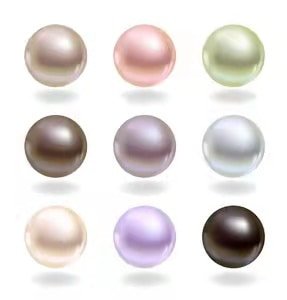 Different colors of pearls
Different colors of pearls
(4) Look at the cleanliness of the pearl skin, that is, the imperfections of the pearl skin.
Why should we look at the blemishes of pearls now and not in the front? Is the so-called flawless pearl, even if it is the top pearl, as long as you look very carefully, there will be a slight defect on the surface. So if you emphasize in front of the flaws, you can’t choose the back because every pearl will have imperfections. We look at gloss first because a pearl with an intense show has a strong reflection that can hide blemishes. At an average social distance, the other person will not see the imperfections of your high-quality pearl skin.
(5) Look at the shape of the pearl
The rounder, the better. Of course, the price will be higher.Why is that? Because if you wear a round bead, no matter which direction the light source comes from, it looks beautiful, so the more round, the more popular. Suppose it is to select freshwater pearls (except Edison pearls). In that case, can place this step before the first step, the water drop shape, rice type, onion shape, and another irregular shape of pearls excluded, leaving round pearls for comparison, the best round pearls. If it is the sea pearl, it is round, so put in the last to consider just as well!
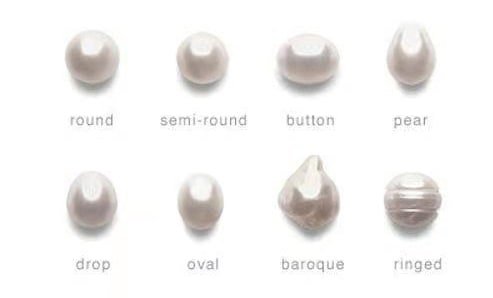 Different shapes of pearls
Different shapes of pearls
(6) Depending on the thickness, the thicker the nacre, the better.
The wider the nacre, the older the pearl has been and the higher its value.
(7) Choose regular channels.
Try to choose merchants who have been engaged in the pearl industry for a long time because they can have a better pearl supply chain. Many pearls in the hands of individual investors belong to the lower level, and some will be optimized, which is easy to step into a pit.
10 points related to pearl jewelry
1.Do not contact with acid and alkali chemicals
Pearls are organic gemstones, so to keep the lustre and colour of pearls from being affected, pearls should not touch the acid, alkali and chemicals, such as perfume, soap, shaping water, so please wear pearl jewellery after makeup and perfume.
2.Keep away from the soot area
The pearl surface has tiny pores, so it is unsuitable for letting the pearl in the dirty air. The pearl will absorb impurities in the air. Be especially careful in the kitchen, wear beautiful pearl cooking dishes, steam and lampblack may seep into the pearl, make it yellow.
3 .Care with cashmere cloth
Wipe the pearls clean before putting them away every time you wear them to maintain the lustre of the pearls. It is best to use sheepskin or fine flannelette, do not use face paper because some face paper friction will wear pearls, let the pearl surface lose lustre.
4.Do not wash with water
Try not to clean the pearl necklace with water. Water can enter tiny pores on the surface of the pearl, which are not only difficult to dry, but may also ferment with other pores, and the pearl line may turn green. If you wear sweat, you can use a soft wet towel to wipe it carefully and put it back in the jewellery box after drying naturally.
5. Close contact with air is required
Do not keep pearls in the safe for long periods, nor seal them with plastic bags. Pearls need fresh air between them, and every few months, they have to air it out and let them breathe. If placed in a closed drying box for a long time, pearls are easy to turn yellow.
6. Avoid exposure to the sun
Because pearls contain a certain amount of water. Pearls should be placed in a cool place and avoided direct exposure to the sun as far as possible to avoid dehydration and yellowing or tarnishing pearls.
7. Anti-scratch
It is best to store the pearl jewellery separately. Hence, as not scratch the pearl cortex with other intricate jewellery and precious stones. If you’re wearing beads on top of your garment, try to wear something soft and smooth to avoid a rough fabric that could scratch your precious pearls.
8. Flat storage
Do not hang the bead chain for a long time. For a long time, the bead line will be loose and deformed, easy to break. It is best to put the bead chain flat collection.
9. Regular inspection, three years for thread change
Silk thread is easy to lose for a long time, so it is necessary to check regularly. Whether the silk thread is loose and replaces it, pearls should be re-stringing once every three years, depending on the number of times they are worn. So as not to break suddenly .when it needs to be worn, which often leads to the loss of precious pearls.
10. Pearl yellow remedy
After the pearl yellow can be soaked with dilute hydrochloric acid. It can dissolve the yellow shell so that the pearl to reproduce the glittering and translucent gorgeous, charming colour and lustre. But if the colour turns yellow enough, it is not easy to reverse
6 famous pearls we need to know
1.Tahiti Pearls
The Tahitian pearl is a black cultured pearl found in French Polynesia in the South Pacific. The mother pearl is a black butterfly shell that secretes black pearls, and Most Tahitian black pearls are 8-16mm in diameter. Although the overall tone is black, they have colorful color halos. Malachite green, thick purple, and sea blue are common and very attractive. Malachite green is of the highest value.
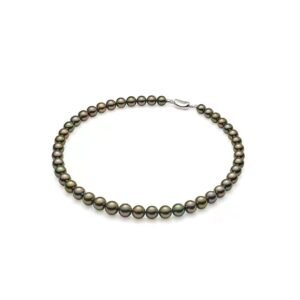 Tahiti Pearls
Tahiti Pearls
2. Akoya pearls
The Akoya pearl, named after the Japanese pronunciation of its mother, Ma’s shell (あこや), is a cultured sea pearl produced in Japan. The most significant characteristic of Akoya pearl is its extreme pearl luster, often colored in pink, silver, blue-green. The pink variety has the highest value, but its particles are small, mostly 6-9mm in diameter.
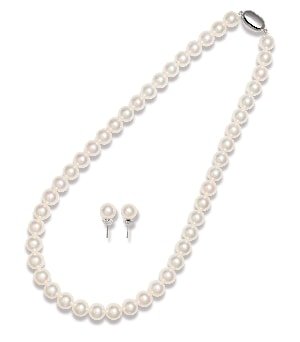 Akoya pearls
Akoya pearls
3. Mabe Pearls
Mabe pearl, also known simply as MABE pearl, derives its name from the pronunciation of the Japanese word MABE, which refers to a regenerated pearl with a unique semicircular structure. MaBe beads are cultured by inserting a pearl nucleus into the inner side of the shell of MaBe after collecting the cultured pearls. Its diameter can be up to 10-20mm, a unique shape. The back is flat, and the surface has the luster of the rainbow. It is also known as the “dream pearl” due to its rarity and preciousness. With the improvement of artificial breeding technology, the horse-shell beads with unique shapes, such as water drop, heart, olive, can now be produced.
 Mabe Pearls
Mabe Pearls
4. Edison pearls
Edison pearl is a high-tech research and development of ecological aquaculture freshwater pearls in recent years, is the first brand of China Beauty Pearl. Its quality is better than the traditional freshwater cultured pearls, with a high round rate, large particles, bright luster, rich colors, and other characteristics. Its diameter can reach 11-20mm, and at the same time, it breaks through the color shortage of traditional freshwater pearls. In addition to the familiar gold and white, it adds copper, deep purple, violets, and other particular metal color varieties. Edison pearl is one of the most popular freshwater pearls in recent years.
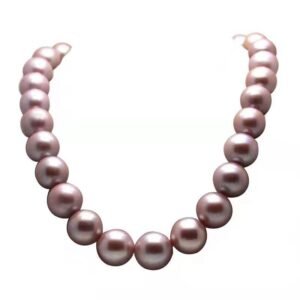 Edison pearls
Edison pearls
5.Baroque pearls
Baroque pearl is a general term for special-shaped pearls, referring to those pearls with irregular shapes. Although the body is particular, it is also given a unique design conceived by jewelry designers. A piece of exquisite jewelry has been achieved.
 Baroque pearls
Baroque pearls
6. South Sea Pearl
South Sea Pearl is born in the South Pacific Ocean, the Indian Ocean, and the Pacific Ocean, including the north of Australia, Indonesia, the Philippines, and other places. Australia is rich in pearls, generally called Australian South Sea Pearl. The mother shell of the South Sea Pearl is the white butterfly shell. The individual is significant. The color of the South Sea Pearl is different from white to golden. Its size is usually greater than 9mm. The available diameter is 10-15mm, some can reach 19mm, and the world’s largest South Sea Pearl is 24mm. South Sea Pearl is very precious. The beautiful color of the South Sea Pearl is known as the queen of pearls.
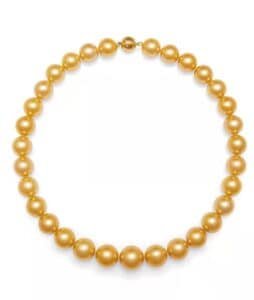 South Sea Pearl
South Sea Pearl
I hope you found this helpful, if you still have different views on pearls, you can contact me, we can discuss them together.